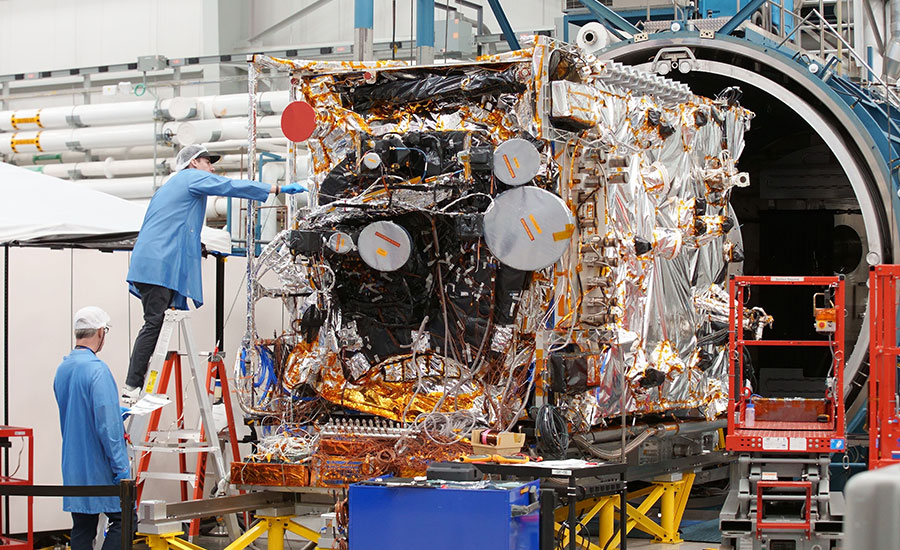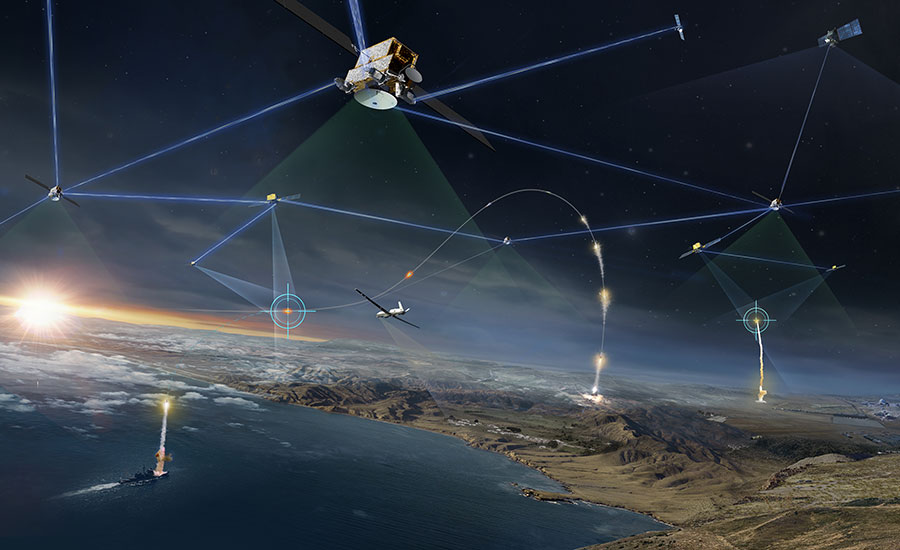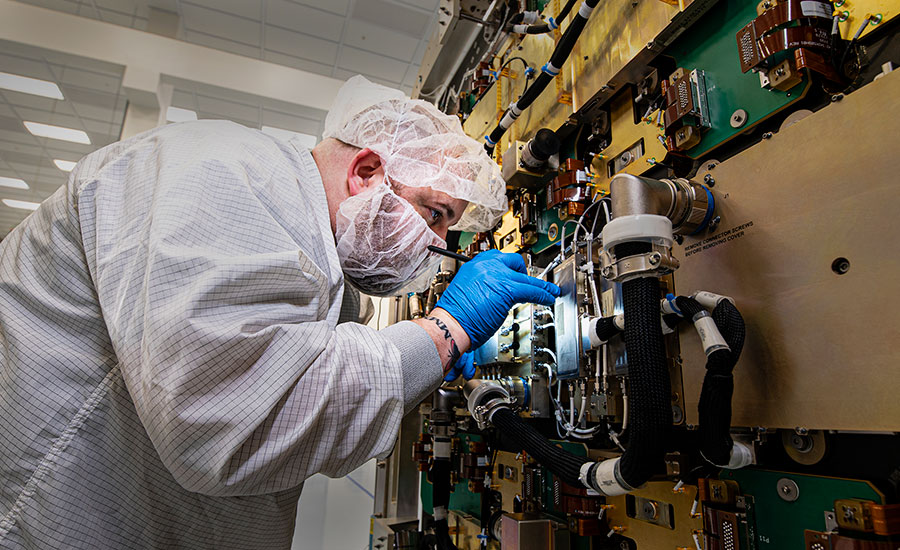Northrop Grumman Uses Augmented Reality to Assemble Satellites
September 4, 2024
Northrop Grumman Uses Augmented Reality to Assemble Satellites
September 4, 2024Northrop Grumman is using augmented reality technology to communicate complex work instructions clearly and intuitively. Photo courtesy Northrop Grumman Aerospace Systems
Augmented reality (AR) technology is a key ingredient of Industry 4.0 and digital manufacturing initiatives. It brings components of the digital world into a person’s perception of reality. AR layers computer-generated imagery onto a user’s view of the real world, providing a composite view.
Northrop Grumman Corp. is one of a handful of leading manufacturers that are using wearable devices to empower assemblers. The company recently invested in AR technology to streamline operations at its historic Space Park facility in Redondo Beach, CA.

The James Webb Space Telescope was assembled at Space Park. Photo courtesy Northrop Grumman
The 63-year-old campus covers approximately 5-million square feet spread out over more than 45 buildings, including more than 100,000 square feet of Class 10 clean room facilities. Inside, engineers design, test and build complex electronics, payloads and advanced systems for a variety of out-of-this-world applications.
Products assembled at the facility over the years have included everything from top-secret military satellites to the James Webb Space Telescope. Current projects include the Tranche 1 Transport Layer mesh satellite constellation and the Next-Generation Polar Infrared Missile Tracking Satellite.
“Augmented reality is a technology that takes our view of the real world and overlays useful and relevant digital data on top of that view,” says Oscar Castillo, a mechanical engineer who serves as factory modernization and digital transformation project manager at Space Park. “This is usually achieved through a smartphone, or in recent years through an AR headset such as Microsoft’s HoloLens.
“As an example, imagine you’re an online consumer shopping for a new couch,” explains Castillo. “You come across an app that allows you to see that couch in your home. Through your phone’s screen you can move and rotate the couch. All these things increase engagement and help you make your purchase decision.

Northrop Grumman assemblers build a variety of complex satellites. Photo courtesy Northrop Grumman
“In contrast, virtual reality replaces your view completely with digital data,” notes Castillo. "So, you could look at that same couch, but instead of it being in your home perhaps it’s in a showroom or in the factory where it was built.
“Both technologies are powerfully effective at communicating complex information, because our minds want to believe what we are seeing,” says Castillo. “We are drawn in, or to use an industry term, immersed.”
Looking for a reprint of this article?
From high-res PDFs to custom plaques, order your copy today!
As part of its digital transformation initiative, Space Park uses both technologies, but in different ways.
“We have found that virtual reality can help our design teams assess a product’s producibility from a human factors or ergonomics perspective,” says Castillo. “Using engineering CAD models, we can spot challenges early enough in the design cycle so that changes can be made without great cost or schedule impact.

The Tranche 1 Transport Layer mesh satellite constellation will support U.S. military missions around the world. Illustration courtesy Northrop Grumman
“Augmented reality helps our production teams communicate complex work instructions clearly and intuitively,” adds Castillo. “This translates into shorter manufacturing time spans, reduced defects and reduced learning curves for our new employees.”
Better Work Instructions
According to Castillo, AR technology is ideal for a variety of manufacturing applications. Most of the products built at Space Park have a 3D CAD model associated with them. Northrop Grumman engineers are leveraging those models to create augmented reality work instructions (ARWI).
When operators put on an AR headset, they look at a partially assembled spacecraft. For instance, they see how a complex wiring harness should be installed and routed.
“[They] see where the support mounts for that harness need to be bonded,” explains Castillo. “You even see where other components will be installed in the future. These are your routing ‘keep out’ zones that you need to avoid.
“Everything is a 1-to-1 scale,” says Castillo. “As you move around, the models and annotations remain anchored to the spacecraft. We can even show our technicians photos, videos and process specs that they can reference to better understand the work in front of them.”
In the past, assemblers relied primarily on text-based work instructions and complex engineering schematics. They spent valuable time interpreting and making sense of them. Sometimes, that took minutes; other times, it could take hours. While interpreting those build instructions, mistakes sometimes would happen.

In addition to augmented reality technology, assemblers at Space Park use virtual reality tools. Photo courtesy Northrop Grumman
“The ARWI project is aimed at delivering clear and intuitive work instructions that will result in reduced time spans, reduced defect rates and reduced learning curves for our newer employees,” says Castillo.
Augmented reality is a key component of Northrop Grumman’s digital transformation strategy. The goals of the initiative are to enhance the employee experience, deliver quality products faster to customers and position the company for the future. AR technology checks all those boxes.
“We have a team that has been working to make this technology accessible across the enterprise,” explains Castillo. “They have evaluated hardware and software, gathered and disseminated resources, and worked with our cybersecurity and IT teams. This year, they are partnering with a few of our sister sites around the country to help them with AR projects.”
Although Space Park has been using AR in production for only about one year, Castillo and his colleagues have been pursuing the technology since 2018.
“Back then, we saw the writing on the wall,” says Castillo. “We saw the big tech companies investing heavily into the technology, and we also saw other organizations in our industry celebrating their success using AR for manufacturing.
“It has been a long road for us, but we are happy to finally share this capability across our campus and realize the benefits in efficiency, quality and employee experience,” notes Castillo.
Space Park uses off-the-shelf hardware and software, such as Microsoft’s HoloLens2 and Scope AR’s on-premise WorkLink.
“Much of our work happens in restricted areas,” says Castillo. “Up until now, AR has been used in our open manufacturing areas. However, we are making good progress with our cybersecurity teams to approve the use of AWRI in all our production areas at Space Park.”
Numerous AR Applications
Castillo and his colleagues are deploying AR technology on the plant floor to build better products and improve productivity. Applications include ergonomics, error proofing, quality control and knowledge transfer.
“We use AR to overlay engineering CAD models on top of the actual spacecraft, sequentially revealing the parts of the model that are most relevant to that task,” explains Castillo. “Picture Lego instructions, but in 3D and projected onto the bricks. We can also add annotations or animation, and we can bring in other models, such as tools or fixtures.
“What I especially appreciate about the technology is how manufacturing now has the capability to communicate in 3D,” says Castillo. “Let’s say there is some domain knowledge that a production team has built over the years. In the past, we would do our best to capture that knowledge using words in our build instructions.
“But now, we have so many more tools at our disposal,” Castillo points out. “That knowledge can be captured and projected back onto the work product, ensuring clear communication of design intent to all parties.”
According to Castillo, AR is a great tool for error proofing. It can reduce errors when positioning or orientating components or tooling, or when it’s important to distinguish between similar but different design features.
“In these cases, AR can improve quality and reduce defects,” says Castillo. “In fact, we had an incident on one of the first ARWI enhanced assemblies. A technician was preparing to bond a component to the spacecraft, but relied on traditional work instructions and drawing views.

The Next-Generation Polar Infrared Missile Tracking Satellite will detect ballistic missile launches. Illustration courtesy Northrop Grumman
“A second technician, who happened to be less experienced, picked up the AR headset, fired up the ARWI, and immediately saw that the location that was being prepped for bonding was the wrong location,” explains Castillo. “Thankfully, they caught the error before it was considered a defect. This saved us up to three days of schedule time.”
AR technology can also help address issues and challenges related to knowledge transfer. First, there is the communication of design intent to the shop floor, and then there is the communication from production team to production team.
“Because Space Park has a high mix of products that we create at low volume, a technician’s job is almost always a little different,” Castillo points out. “We are in a perpetual state of generating and interpreting new build instructions that aim to capture the design intent. By leveraging the design models, we can make sure that this design intent is preserved and literally projected right onto the work, cutting through many layers of manual knowledge transfer processes.
“In addition, because of that high mix of products and tight schedules, our production teams are not always 100 percent sure of how they are going to assemble a product,” says Castillo. “Some of our planning must be left flexible, allowing production teams to iterate and adjust their plans.
“AR can be used to capture that flow,” adds Castillo. “This can be very helpful to communicate to downstream teams that will continue the manufacturing of this product or future teams that are looking for ‘lessons learned’ when building similar products.
“Currently, we aren’t using AR for employee training, but it is on our roadmap,” says Castillo. “There are specific integration and test skills that are fairly universal across the various satellite products we deliver. We believe there is a great opportunity to create AR to support that kind of training.”
How to Deploy Augmented Reality in a Factory Setting
Implementing augmented reality technology in a factory can be challenging. For instance, veteran employees may resist using wearable devices that some people associate with gamers.
Oscar Castillo, a mechanical engineer who serves as factory modernization and digital transformation project manager at Northrop Grumman’s Space Park, has several tips for other engineers.
“I’ve been leading digital transformation projects at Space Park for about five years and one of my common sayings is that the technology is the easiest part of the job,” says Castillo. “Implementing large change within an organization is where most of your time will be spent.”

AR technology is ideal for a variety of satellite manufacturing applications. Photo courtesy Northrop Grumman
According to Castillo, four things can ensure a smooth transition:
For more information on space manufacturing, read these articles:
Assembling a Wire Harness for Deep Space
Work Platforms Help Assemblers Reach for the Stars
Microgravity Manufacturing Inches Closer to Reality









